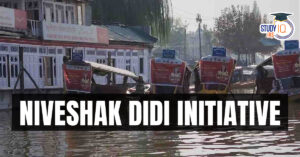Daily Current Affairs for UPSC 2023
Q) Recently seen in news, the ‘Global Multi-Dimensional Poverty Index’ is released by which one of the following organizations?
- World Economic Forum
- United Nations Development Programme
- International Development Association
- Organization for Economic Co-operation and Development
Daily Current Affairs for UPSC – 11 July April 2023
Explanation:
- Option (2) is correct: The United Nations Development Programme (UNDP) has released the Global Multi-Dimensional Poverty Index 2023. The global MPI is a key international resource that measures acute multidimensional poverty across more than 100 developing countries. It was first launched in 2010 by the Oxford Poverty and Human Development Initiative (OPHI) and the Human Development Report Office of the UNDP. It goes beyond traditional income-based measures of poverty by considering multiple dimensions of deprivation, including health, education, and living standards. The Global MPI is released at the High-Level Political Forum (HLPF) on Sustainable Development of the United Nations in July, every year. The Global MPI uses three standard dimensions: Health; Education; Standard of Living and ten indicators. Global MPI is computed by scoring each surveyed household on 10 parameters based on –nutrition, child mortality, years of schooling, school attendance, cooking fuel, sanitation, drinking water, electricity, housing and household assets.
Q) Consider the following statements about Protection of Plant Varieties and Farmers Rights Act, 2001:
- As per the act, a researcher can use any of the registered varieties for conducting experiments.
- A breeder’s registration may be withdrawn if he fails to supply the necessary seeds for a compulsory license.
- In accordance with the Act, farmers are not required to pay any fees in any proceeding before the High Court.
How many of the statements given above are correct?
- Only one
- Only two
- All three
- None
Explanation:
- Statement 1 is correct: Protection of Plant Varieties and Farmers Rights Act, 2001 provides an effective framework to conserve and encourage the development of various plant varieties. It aims to establish an effective system for the protection of plant varieties, the rights of farmers and plant breeders and to encourage the development of new varieties of plants. Researcher can use any of the registered varieties under the Act for conducting experiment or research. This includes the use of a variety as an initial source of variety for the purpose of developing another variety but repeated use needs prior permission of the registered breeder.
- Statement 2 is correct: According to Section 34 of the PPV&FR Act, the protection granted to a breeder may be revoked by the authority on the following grounds:
- Grant of a registration certificate is based on incorrect information furnished by the applicant;
- Registration certificate was granted to an ineligible person;
- When the breeder does not provide the registrar with the required documents;
- A failure to provide an alternative denomination for variety registration in case the earlier variety provided is not permissible for registration;
- A failure of the breeder to provide the required seeds for compulsory licence;
- Failure to comply with the acts, rules, regulations and directions issued by the Authority;
- If the grant of the registration certificate is against public interest.
- Statement 3 is correct: A farmer who has evolved or developed a new variety is entitled for registration and protection in like manner as a breeder of a variety. Farmer’s variety can also be registered as an extant variety. A farmer can save, use, sow, re-sow, exchange, share or sell his farm produce including seed of a variety protected under the PPV&FR Act, 2001. Farmer shall not be liable to pay any fee in any proceeding before the Authority or Registrar or the Tribunal or the High Court under the Act.
Q) With reference to Central Bank Digital Currency (CBDC), consider the following statements:
- CBDC is a type of digital legal tender issued by a central bank.
- CBDCs make use of a secure private blockchain network.
- Unlike cash, CBDC deposits can earn interest in a bank.
How many of the statements given above are correct?
- Only one
- Only two
- All three
- None
Explanation:
- Statement 1 and 2 are correct: Central Bank Digital Currency (CBDC) is the legal tender issued by a central bank in a digital form. It is the same as a fiat currency and is exchangeable one-to-one with the fiat currency. Only its form is different. A government-issued currency is known as fiat money. CBDCs use a private Blockchain network that has prior permission. The concept of CBDCs was directly inspired by Bitcoin but it is different from decentralised virtual currencies and crypto assets, which are not issued by the state and lack the ‘legal tender’ status.
- Statement 3 is incorrect: Like cash, the CBDC will not earn any interest and can be converted to other forms of money, like deposits with banks. CBDCs will be linked to an individual’s bank account, which will have their personal data. The digital Rupee-Retail (e₹-R) is an electronic version of cash and is primarily meant for retail transactions to be used by the private sector, non-financial consumers and businesses.
Q) Consider the following statements about Electoral Bonds:
- Electoral Bonds can be purchased by a company incorporated in India.
- As per the Association of Democratic Reforms, electoral bonds were the chief source of donations for political parties in the last five years.
- The political parties that received less than two percent of the total votes cast in the general election are qualified to obtain Electoral Bonds.
How many of the statements given above are correct?
- Only one
- Only two
- All three
- None
Explanation:
- Statement 1 and 2 are correct: Electoral Bonds are like Promissory Notes which can be purchased by any individual who is an Indian Citizen or a body corporate which is established or incorporated in India. The Individual or the body corporate can donate the purchased Electoral Bond to any eligible political party of his or her choice. The Concept of the electoral bond was introduced with the Finance Bill, 2017. According to a report by the Association of Democratic Reforms (ADR), electoral bonds were the chief source of donations for political parties between 2016-17 and 2021-22. Between 2016-17 and 2021-22, seven national and 24 regional parties received a total donation of₹16,437.63 crore. Out of the total donations, 55.9% was from the electoral bonds, 28.07% was received from the corporate sector and 16.03% from other sources.
- Statement 3 is incorrect: Only the Political Parties registered under Section 29A of the Representation of the People Act, 1951 and which secured not less than one per cent of the votes polled in the last General Election to the House of the People or the Legislative Assembly of the State, shall be eligible to receive the Electoral Bonds.
Q) With reference to Goods and Services Tax (GST) Council, consider the following statements:
- A majority of at least three-fourths of the weighted votes cast is required to finalize a decision in the GST Council.
- The GST council has levied an 18 percent GST on the turnover of the online gaming companies.
Which of the statements given above is/are correct?
- 1 only
- 2 only
- Both 1 and 2
- Neither 1 nor 2
Explanation:
- Statement 1 is correct but statement 2 is incorrect: The Goods and Services Tax (GST) Council at its 50th meeting has decided to impose a 28% tax on the turnover of online gaming companies, horse racing and casinos. Goods and Services Tax (GST) Council is a constitutional body responsible for making recommendations on issues related to the implementation of the Goods and Services Tax (GST) in India. Article 279A of the Indian Constitution gives power to the President of India to constitute a joint forum of the Centre and States called the GST Council. During its meetings, the GST Council takes decisions through a consensus-based approach promoting the spirit of the co-operative federalism. Decisions in the GST Council are taken by a majority of not less than three-fourth of weighted votes cast. Centre has one-third weightage of the total votes cast and all the states taken together have two-third of weightage of the total votes cast.


 Niveshak Didi Initiative Phase 2 launche...
Niveshak Didi Initiative Phase 2 launche...
 Central Pollution Control Board (CPCB) R...
Central Pollution Control Board (CPCB) R...
 Foreign Contribution Regulation Act (FCR...
Foreign Contribution Regulation Act (FCR...





















